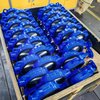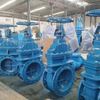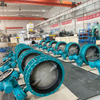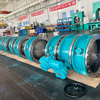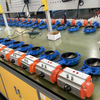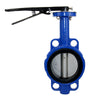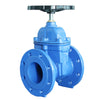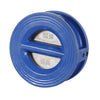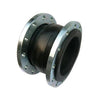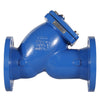The Difference Between Check Valve And One Way Valve
One-way valves are sometimes called check valves, although they are similar in some ways, but in the structure, principle and function are different, today we will speak from these three aspects of the difference between one-way valves and check valves.
Difference in functions
One way valve
A one-way valve, also known as a check valve or non-return valve, is a mechanical device that permits fluid to flow in only one direction—from the inlet to the outlet—and automatically prevents reverse flow. This function is essential for protecting pumps, compressors, and sensitive equipment from damage, avoiding pressure surges, and maintaining system efficiency.
In hydraulic systems, one-way valves prevent hydraulic oil from flowing backward when the pump stops or the system is depressurized, ensuring stable pressure and preventing component wear. In pneumatic systems, they stop compressed air from reversing direction, helping maintain consistent pressure levels and preventing air loss. In water supply networks, one-way valves are often installed to avoid contamination from backflow into the clean water line, meeting public health and safety standards.
Structurally, a typical one-way valve is composed of three main elements:
-
Valve body – the robust housing that connects to the pipeline and withstands system pressure.
-
Spool/disc/ball – the movable element that opens when forward flow exceeds a certain pressure and closes when flow stops or reverses.
-
Spring – ensures the valve remains closed under low pressure and provides a set cracking pressure before opening.
Depending on the application, one-way valves can be made from stainless steel, brass, PVC, or other corrosion-resistant materials, and are available in designs such as ball check valves, swing check valves, and piston check valves. Proper selection depends on factors like operating pressure, flow rate, fluid type, and installation orientation.
Whether used in industrial process lines, irrigation systems, HVAC loops, marine piping, or chemical transfer lines, the one-way valve plays a critical role in ensuring safety, efficiency, and long service life for the entire system.
Check Valve
A check valve is a type of valve that automatically prevents backflow. It works by using a round valve component that opens or closes based on its own weight and the pressure of the fluid. When the fluid flows in the right direction, the valve stays open, but if the fluid tries to flow backward, the valve closes to block it. This valve is also known as a non-return valve, backflow preventer, or isolation valve. Its main purpose is to stop the fluid from flowing back, protect pumps and motors from reversing, and prevent the unwanted discharge of fluid from a container.
Functional difference:
One-way valve is mainly used to control the one-way flow of fluid and prevent reverse flow. Its function is to control the flow direction through the opening and closing of the valve spool or valve flap, allowing the fluid to flow in only one direction.
Check valve is mainly used to prevent the reverse flow of fluid. Its function is to close when the fluid flows in the opposite direction, preventing the liquid or gas in the pipeline from flowing backwards after stopping the supply.
In other words, a one-way valve has a tendency to control flow direction, while a check valve operates naturally.
Different working principles
Working principle of One-way valve
Open State: When liquid enters the valve, the pressure pushes the valve’s spool (a moving part) against the spring, opening the valve. As the liquid flows through, the spring gradually tries to pull the spool back to close the valve. However, because of the fluid’s momentum and the pressure at the outlet, the spool doesn’t close right away, allowing the fluid to keep flowing.
Closed State: When the pressure at the inlet is higher than at the outlet, the spool opens, letting the fluid flow forward. If the pressure at the outlet becomes higher than at the inlet, the spool is pushed back to its seat, closing the valve and stopping any backward flow. At this point, the valve is in the closed state.
Working principle of Check Valve
Check valves are highly responsive to the flow of fluid and depend on the pressure and direction of the flow to open and close. Inside the valve, there’s a flap that allows fluid to move forward, which opens the valve. If the forward flow slows down or reverses, the flap starts to close the valve to prevent backflow. These valves are typically simple, with just a few main parts like the body, seat, flap, and bonnet. Depending on the design, other parts might include valve stems, hinge pins, disc arms, springs, balls, elastomers, and bearings.
Different working principles : generally common one-way valve principle is from the pressure difference between the inlet and outlet, through this pressure difference to ensure that the valve opens and closes; check valve should belong to the non-control valve, so it will be called automatic valve, relying on the pipeline pressure and flow to control the opening and closing.
Different structures
Structure of One-way valve
1.According to the different spool structure, one-way valve can be divided into two types: ball valve type and cone valve type.
- Ball valve spool structure is simple, but easily due to friction and sealing deterioration, only for low-pressure occasions.
- Cone valve process requirements are strict, but the sealing is good, the check valve used in the project is mostly cone valve structure.
2.According to the valve in the channel, the one-way valve can be divided into two types of straight-through and right-angle type.
- Straight-through one-way valve with threaded connections installed in the pipeline.
- Right-angle one-way valve have threaded connections, plate connections and flange connections in three forms.
- The structure of the right-way one-way valve is relatively simple, the fluid resistance is small, but the direction of fluid flow is not intuitive.
- Angle one-way valve fluid flow direction perpendicular to the pipeline axis, fluid resistance is greater, but the direction of fluid flow is more intuitive.
Structure of Check Valve Structure
Check valves can be divided into silent check valves, swing check valves、 dual plate wafer check valve and Ball type check valve according to their structure.
Swing check valve is divided into single-valve, double-valve and multi-valve type.
dual plate wafer check valve for butterfly double flap, butterfly single flap, the above types of check valves in the form of connection can be divided into threaded connection, flange connection, welding and clamped connection four.
Silent Check Valve
Working principle: The inside of a silent check valve usually contains a valve body and valve flap. When fluid is flowing in the forward direction, the valve flap is opened by the pressure of the fluid, allowing the fluid to pass through the valve. However, when the fluid flows in the opposite direction, the valve flap is pushed closed by the reverse pressure of the fluid, thus preventing the fluid from flowing backwards. At the same time, the design of the Silent Check Valve minimises the sound of water slamming and vibration that occurs when the valve is closed, keeping the system quiet and stable.

Swing Check Valve
Working principle: rotary check valve valve flap and rocker is connected together, when the pipeline fluid flows in the specified direction, the valve flap inlet pressure is higher than the outlet pressure, the valve flap is pushed away from the valve seat, rotating around the pin, the valve is in the open state. When the pressure on both sides of the valve flap is reduced to a certain point, the valve flap falls and returns to the closed state. Suitable for low flow rate and flow of infrequent changes in large calibre occasions, but should not be used for pulsating flow.

Swing check valve installation location is not restricted, it can be installed in the horizontal, vertical or inclined pipeline, such as installed in the vertical pipeline, the medium flow direction should be from bottom to top.
Working principle: When the medium flows in the specified direction, the valve is opened by the force of the medium; when the medium flows backward, the sealing surface of the valve flap and valve seat is closed due to the self-weight of the valve flap and the role of the reverse force of the medium, so as to prevent the medium from flowing backward.

Dual plate wafer check valve installation position is not restricted, can be installed in the horizontal pipeline, can also be installed in the vertical or inclined pipeline.
Ball Type Check Valve
Working principle:Ball type check valve through the rotation of the ball to achieve the opening and closing, when the fluid flow to the valve, the ball is driven by the fluid force, so that the valve opens, and vice versa when the fluid direction is reversed, the ball by the sealing ring on the seat of the sealing effect, the valve closes, and play a role in preventing the backflow of fluids.

Structural differences: check valve design is relatively simple, the main difference is that the structure of the spool is different; while the design of the check valve is more complex, including a variety of types (lsilent check valves, swing check valves、 dual plate wafer check valve and Ball type check valve, etc.), can be applied to more demanding environments.
Concluding Remarks
In a nutshell, One-way valves are mainly used to control the one-way flow of fluids, while check valves are mainly used to stop the backflow of fluids. Different in function, structure and working principle, these two types of valves have their unique application value and importance in different fields and scenarios. Therefore, it is necessary to confirm the specific application according to the actual situation.
Union Valves is a professional manufacturer of check valves in China, offering various models and specifications. For more information, please contact us.
Related Article:
- How to Choose the Right Check Valve for Your System
- Choosing the Right Valves for Efficient Water Supply Systems


